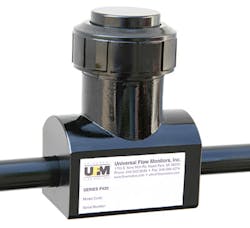Cost-effect Corrosive Fluids Flowmeter
The P420 Series meets requirements for an inexpensive flow rate transmitter without moving parts that can stick, bind or coat when processing water or corrosive fluids. The Series includes models with wetted parts entirely of PVC (polyvinyl chloride) or CPVC (chlorinated polyvinyl chloride) for greater heat resistance. P420 vortex shedding meters with CPVC body, sensor and bluff can transmit hot water or other fluid with maximum operating temperature of 180°F, compared to a maximum 140°F with PVC units. CPVC transmitters can accommodate higher maximum operating pressures than PVC units at temperatures of 80°F to 180°F. Both CPVC and PVC units are offered in five pipe diameters providing a flow range from 12 to 200 gallons per minute.Universal Flow Monitors Inc.www.flowmeters.com248.542.9635

